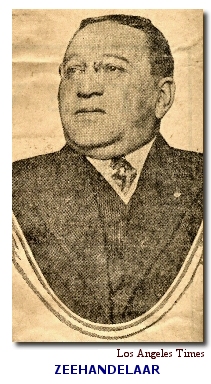 on Oct. 12, 1924.
on Oct. 12, 1924.
Thursday, December 27, 2007
Page 11
REMINISCING (Column)
Felix J. Zeehandelaar: a Man Called ‘Zee’
By ROGER M. GRACE
He never served as president of the Merchants’ and Manufacturers’ Assn. of Los Angeles. But for 27 years, he was its guide, its voice, its symbol. When the M & M issued a public statement, it was he who signed it.
Felix
J. Zeehandelaar—known as “Zee”—served as its “secretary”…a position of a sort
which is nowadays termed “executive director”…from Aug. 1, 1897 (slightly more
than a year after the M & M was formed) until his death on Oct. 12, 1924.
on Oct. 12, 1924.
He succeeded the group’s first secretary, William Knight, who was, as the Times’ July 28, 1927 account politely puts, “requested to retire.”
His background was neither in business nor administration. He was a newspaperman.
Born Dec. 13, 1852, at The Hague, Holland, where he was educated, Zeehandelaar came to San Francisco in 1872, working from 1880-90 as a reporter for the San Francisco Examiner, city editor of the Spokane (Wash.) Spokesman in 1891, and reporter for the Los Angeles Herald in 1892.
It was while working for the Examiner that he became the Bill Farr of his day. He in 1886, like Farr in the 1970s, was jailed for contempt for refusing to disclose his confidential news sources.
As Related in “Newspaper Libel: A Handbook for the Press” by Samuel Merrill, published in 1888:
“During a divorce trial in the Superior Court in San Francisco the Examiner published full reports of the testimony, although the hearing was held with closed doors. The judge issued strict orders to the officers of the court and to witnesses not to divulge any of the proceedings. The Examiner continued to report the trial in full. Felix J. Zeehandelaar, who was cited to appear, and was asked where he got his information. He refused to answer the questions, and was adjudged guilty of contempt of court, and was remanded to the custody of the sheriff.”
The “question” asked of Zeehandelaar by Judge Jeremiah F. Sullivan—actually, a declaratory sentence implying a question—was this: “I desire to know if Mr. Hinkle [the husband] or Mr. Lowenthal [his attorney], or anybody connected with Mr. Lowenthal’s office who has been present during the trial, has made to you any statements as to what transpired during the progress of the trial.”
No ethical journalist then, or since, if faced with a demand to disclose confidential sources of information, could have done other than what Zeehandelaar did: remain mum.
A Times story appearing on Aug. 3, 1886, relates that the previous day, in what would today be regarded as extraordinary rapidity, San Francisco Superior Court Judge James Maguire denied Zeehandelaar’s petition for writ of habeas corpus; a like petition was filed in the California Supreme Court; that court proceeded to order the filing of briefs within three days; Zeehandelaar was released on bail.
In an Oct. 29 opinion, the high court ordered that the contempt adjudication be scuttled. There was a lead opinion and were three concurring opinions. The upshot was that there was no showing that the inquiry of the reporter related to any issue before the court—that is, the divorce—so there was a lack of jurisdiction over Zeehandelaar.
In 1895, Zeehandelaar was hired by the M & M to publicize its fiesta. Two years later, he became secretary, and was soon recognized by members as the association’s prime asset.
As the M & M increasingly turned its attention to preserving the open shop in Los Angeles, Zeehandelaar became an emblem, nationally, of the fight against the unions. In 1910 when the Times was bombed by union terrorists, dynamite was placed at Zeehandelaar’s home but did not ignite.
The obituary on Zeehandelaar in the Oct, 13, 1924 edition of the Times refers to him as “[f]earless and aggressive” and “an able champion of the independent workman.”
Queen Wilhelmine of the Netherland in 1907 designated Zeehandelaar as vice consul for Southern California and Arizona, later elevating him to the post of consul, and bestowing a knighthood on him six months before his death.
The focus this year has been on two tenants in the Wilcox Building: Hans Jevne and the M & M. Next year, I’ll look at others who have occupied space here.
Copyright 2007, Metropolitan News Company